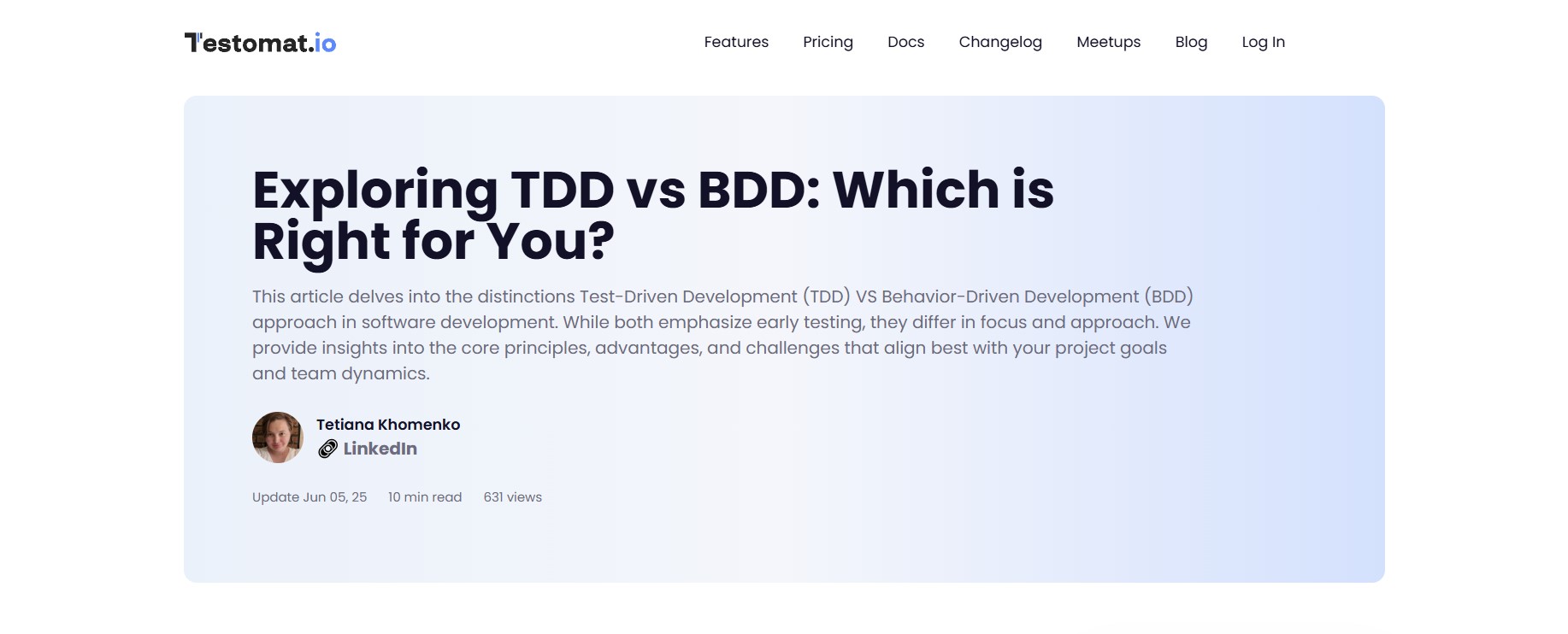BDD vs TDD: Which Approach Fits Your Development Needs Best?

Strong 8k brings an ultra-HD IPTV experience to your living room and your pocket.
In the ever-evolving world of software development, two methodologies often come up for discussion: Behavior-Driven Development (BDD) and Test-Driven Development (TDD). Both approaches aim to improve software quality, ensure maintainability, and facilitate collaboration between teams. Yet, many developers, testers, and project managers find themselves asking: **Which approach is right for my project?** Understanding the nuances between BDD vs TDD is crucial to making an informed decision that aligns with your team’s goals and project requirements.
This article explores the fundamental differences, benefits, and practical applications of BDD and TDD. By diving deep into their principles and how they impact software delivery, you’ll gain clarity on when and why to choose one over the other. For a comprehensive guide and further insights, visit [BDD vs TDD](https://testomat.io/blog/exploring-tdd-vs-bdd-which-is-right-for-you/).
---
## Understanding Test-Driven Development (TDD)
Test-Driven Development, or TDD, is a software development practice that emphasizes writing tests before writing the actual code. The TDD process typically follows a cycle often summarized as **Red-Green-Refactor**:
* **Red:** Write a failing test that defines a desired function or improvement.
* **Green:** Write the minimum code necessary to pass the test.
* **Refactor:** Clean up the code while ensuring tests still pass.
This approach ensures that code is always backed by tests, promoting higher code quality and preventing regression. TDD encourages developers to think carefully about design and functionality before implementation, which often leads to simpler and more modular code.
Key characteristics of TDD include:
* Focus on units of code, often functions or classes.
* Writing tests primarily for the developer’s use.
* Emphasis on correctness and completeness at the code level.
* Helps uncover edge cases early in development.
TDD’s strength lies in its granularity and developer-centric approach. However, it sometimes lacks clarity in communicating requirements to non-technical stakeholders, which leads to the rise of complementary methodologies like BDD.
---
## What is Behavior-Driven Development (BDD)?
Behavior-Driven Development is an evolution of TDD aimed at improving communication among developers, testers, and business stakeholders. It bridges the gap between technical and non-technical team members by focusing on the **behavior** of the application rather than just the code.
BDD uses natural language descriptions written in a format such as **Given-When-Then** to specify application behavior in scenarios or user stories. These scenarios become executable specifications that guide development and testing.
For example:
* **Given** a user is logged in,
* **When** they add an item to the cart,
* **Then** the cart should update with the new item.
Key aspects of BDD include:
* Emphasis on collaboration and shared understanding.
* Scenarios written in human-readable language.
* Focus on system behavior rather than implementation details.
* Tests serve as living documentation for the product.
BDD fosters a shared language among all project participants, which reduces misunderstandings and aligns expectations. It often leverages tools like Cucumber or SpecFlow to automate these behavior specifications.
---
## Comparing BDD vs TDD: What Sets Them Apart?
Although BDD and TDD share common roots and goals, they differ fundamentally in focus, process, and output. Here’s a detailed comparison:
| Aspect | TDD | BDD |
| ----------------- | ------------------------------------------- | ------------------------------------------------- |
| **Focus** | Unit tests on code functions and components | Application behavior and user outcomes |
| **Test Author** | Developer | Cross-functional team including business, QA |
| **Test Language** | Code-centric (e.g., JUnit, NUnit) | Natural language (Given-When-Then) |
| **Collaboration** | Primarily developer-driven | Encourages collaboration between all stakeholders |
| **Documentation** | Tests serve as developer documentation | Scenarios act as living, shared documentation |
| **Tools** | Frameworks like JUnit, NUnit, xUnit | Tools like Cucumber, SpecFlow, Behave |
| **Granularity** | Very granular, focusing on units | Higher level, focusing on features and workflows |
| **Outcome** | Ensures code correctness | Ensures software meets business requirements |
Understanding these distinctions helps teams decide which methodology better fits their workflow, culture, and project demands.
---
## When to Use BDD or TDD?
Choosing between BDD vs TDD isn’t always a matter of one or the other. Many teams find value in combining both approaches for a balanced development and testing strategy. Here are scenarios where each shines:
### Use TDD when:
* Developing complex algorithms or low-level components where precise control is necessary.
* You want to ensure code quality and prevent regressions early.
* Your development team prefers fine-grained testing and iterative design.
* The project demands high reliability in core logic, such as financial calculations or critical systems.
### Use BDD when:
* Collaboration between business stakeholders, QA, and developers is vital.
* The project requirements are evolving and need clear, shared understanding.
* You want automated acceptance tests that are understandable by non-technical team members.
* Documentation that reflects current functionality is a priority.
Many agile teams use BDD to define and validate feature requirements and then apply TDD to implement the internal logic ensuring robustness.
---
## Benefits of Adopting BDD vs TDD
Each methodology offers distinct advantages that can enhance your development lifecycle:
### Benefits of TDD
* **Improved Code Quality:** Writing tests first reduces bugs and promotes clean design.
* **Refactoring Safety:** Tests provide confidence to refactor code without breaking functionality.
* **Faster Debugging:** Tests help isolate problems quickly.
* **Better Design:** Forces developers to think about interfaces and usage upfront.
### Benefits of BDD
* **Enhanced Communication:** Clear, shared understanding of requirements among all team members.
* **Living Documentation:** Scenarios double as up-to-date documentation.
* **Reduced Misunderstandings:** Natural language tests prevent misinterpretation of features.
* **Focused Testing:** Tests concentrate on expected user behavior rather than implementation.
By understanding these benefits, organizations can better tailor their processes to fit team dynamics and project complexity.
---
## Implementing BDD and TDD in Your Workflow
To get the most from BDD vs TDD, consider these best practices:
* **Start with clear requirements:** In BDD, ensure user stories are well defined with acceptance criteria. In TDD, have clear functional goals before writing tests.
* **Automate your tests:** Use appropriate frameworks to automate execution, reporting, and integration with CI/CD pipelines.
* **Maintain test suites:** Regularly review and refactor tests to keep them relevant and efficient.
* **Encourage collaboration:** Facilitate workshops or sessions where developers, testers, and business analysts create BDD scenarios together.
* **Educate your team:** Provide training on both methodologies so everyone understands their purpose and application.
Adopting these practices helps your team reap the full benefits of both BDD and TDD.
---
## Tools to Support BDD and TDD
The software ecosystem offers many tools tailored to both methodologies:
* **TDD Tools:** JUnit, NUnit, xUnit, Mocha, Jest.
* **BDD Tools:** Cucumber, SpecFlow, Behave, Gauge.
Test management platforms such as Testomat can help integrate both approaches, providing streamlined test case management, execution tracking, and collaboration features.
For a detailed breakdown of BDD vs TDD with examples and tool recommendations, visit [BDD vs TDD](https://testomat.io/blog/exploring-tdd-vs-bdd-which-is-right-for-you/).
---
## Conclusion: Making the Right Choice for Your Project
The decision between BDD vs TDD ultimately depends on your team’s structure, project requirements, and collaboration needs. TDD excels in ensuring code quality at a granular level, while BDD fosters shared understanding and business-focused testing.
By combining both, teams can build high-quality software that meets technical and business expectations. Investing time to understand these methodologies and adopting the right tools will empower your development process and lead to more successful project outcomes.
Explore in depth how to leverage BDD vs TDD for your next project and enhance your testing strategy by visiting [BDD vs TDD](https://testomat.io/blog/exploring-tdd-vs-bdd-which-is-right-for-you/).
---
This comprehensive guide aims to clarify the differences and synergies between BDD and TDD, helping you choose the most effective approach for your software development journey.
https://testomat.io/blog/exploring-tdd-vs-bdd-which-is-right-for-you/
Note: IndiBlogHub features both user-submitted and editorial content. We do not verify third-party contributions. Read our Disclaimer and Privacy Policyfor details.


